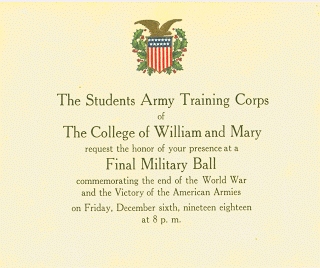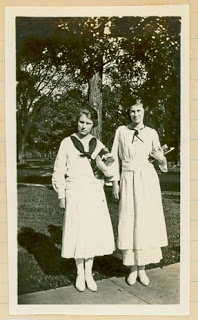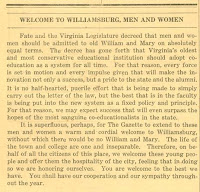Nov. 26, 1918.
Today has been so wonderful that I must begin my book here and go back to catch up past events.
Yesterday evening Florence Harris, our beloved first student government president announced her resignation on account of the fact that she was leaving school for family reason[s]. I think she has to take care of her little brothers.
This evening I was elected president of our Student Government with a nomination of fourteen to four. I certainly appreciate the honor, probably the greatest I have ever had. But I dread the responsibility.
After many controversies and much worry this summer, I decided to come to Wm. and Mary, this first year of its coeducation. I do not now regret my choice.
I arrived here on Sept. 19, and came up in an automobile with Ruth Conkey and Celeste Ross. After several days we got straight and had classes one day before we were quarrantined [sic] for Spanish influenza.
This was a good thing for us. None of the girls had it so we used our time in getting well acquainted. We had met none of the boys and the quarantine served to make them want to meet us.
One evening we had a match game of basket ball to cheer Miss Gatling and incidentally ourselves. Celeste and Florence were the capitans [sic]. I played jumping center by boys' rules against Louise Reid and shot the first and only goal thus winning the game for our side. This started my basket ball "rep" here, and I only hope I can keep it at its present glow.
Soon after the quarrantine [sic] the Lieutenants and a few non-coms came over one night. This started our social hour. Since then the boys come over everynight[sic] after supper until call to quarters or on Sat. and Sunday until 10:00. I have met some very nice boys but don't enjoy it much because dancing has been the chief amusement.
One event that has amused me very much and annoyed me at the time was the water throwing affair. Mr. Simmons, Mr. Elliott, and Mr. Lyons are seniors here. They decided to calm some ducks [freshmen] who were singing under their windows so [they] threw out a bag of water. The bag hit the fire escape and drenched the all important Capt.Van Dusen and Lieutenant Taylor. They were furiously angry and stirred up quite a commotion over it. A few days later the whole S.A.T.C. lined up and marched Lyons and Simmons to the depot to ship them. Dr. Clark, Prof. Keeble, and others succeeded in making Capt. Van Dusen have them brought back. The girls were very indignant over this affair, especially Catherine.
On Hallowe'en night we had quite an enjoyable party.
I made there [sic] with John Chappell, the first boy here with whom I've been real friends.
Through John, ("Jack"), I met W. Saunders. I learned not to trust mankind through my intercourse with him. Was it because he did not respect me or just his nature?
In here comes a comical incident which I shall not put down in so public an affair as this book but simply a card to recall an amusing day, the day the armistice was signed.
Two weeks after this date I spent a very pleasant Sunday. Sergeant Day came up to see me, and quite unexpectedly Lewis also. I was glad because Lewis seemed to like Day very well. Lewis spent the night in town.
We went to the M.E. Church that night, and I cut Educ. and French to see him off the next morning.
Another event straggles in along here somewhere - our dancing exhibition. Miss Gatling took great pains to teach us some folk and other dances. We did the folk dances in our regular "gym" out fit [sic] and the fancy dances in Grecian costume. My ballet slipper came untied during the first step of one of the dances and I was miserable for a while but didn't fall over it.
In the "Garland Dance" we had garlands made of ivy off the Library. W. Saunders helped me make mine. We decorated the "gym" with honeysuckle from near the monument.
Lest we forget the first box of candy I received at W&M from Lewis on that memorable Sunday, Nov. 3, 1918, when I entertained a Sailor and a Soldier. Shall I ever forget the stares Lewis and I got from the S.A.T.C.'s? No, never.
In memory of my first roommate at college - up to this time my last - except for Janet on Special occasion and my beloved "Pal" sometimes.
We had lots of fun in basketball games. The Orange and Black fought many "peppy" battles. The Orange won two out of the three championship games, also the last one before X-mas. Keep the good work up Orange!
Soon after peace was made the S.A.T.C. began to talk of disbanding. They planned a big dance in the dining Hall here for the last night. I not being a dancer and not being popular was left out.
A number of girls from all over the state came. One Annette Pruden roomed with Ruth Harris across the hall from me. She seemed to be very nice.
She was in my room when Janet hid in the closet then came out looking so cheap. She heard us planning the party at Janet's.






